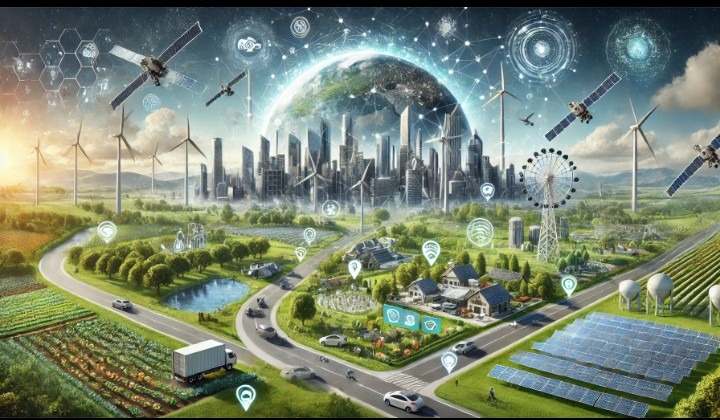In recent decades, technology has played an increasingly vital role in fostering environmental development. From advanced renewable energy solutions to smart waste management systems, innovations in technology offer promising tools to combat climate change, reduce pollution, and promote sustainable living. Here’s how technology is contributing to environmental development:
1. Renewable Energy Innovations:
One of the most significant contributions of technology to environmental protection is in the field of renewable energy. With growing concerns over greenhouse gas emissions from fossil fuels, renewable energy technologies like solar, wind, hydropower, and geothermal have emerged as sustainable alternatives. Advancements in solar panel efficiency, wind turbine designs, and energy storage technologies are helping to reduce reliance on non-renewable energy sources and decrease carbon footprints. For example, solar energy production has become more affordable and accessible, thanks to innovations in photovoltaic cell technology and battery storage systems.
2. Energy Efficiency and Smart Grids:
Technology is also promoting energy efficiency across various industries. Smart grids, for instance, allow for the efficient distribution and consumption of energy. By incorporating digital communication technology into traditional electricity grids, smart grids optimize energy usage, reduce waste, and improve the overall stability of power networks. Moreover, smart meters and energy-efficient appliances help consumers monitor their energy consumption in real-time, encouraging more conscious energy use.
3. Sustainable Agriculture:
Technology has transformed agricultural practices, making them more sustainable and environmentally friendly. Precision agriculture, which uses GPS, sensors, and data analytics, allows farmers to manage their resources more efficiently. This minimizes water usage, reduces pesticide and fertilizer runoff, and lowers the overall environmental impact of farming. Additionally, advances in biotechnology, such as genetically modified organisms (GMOs), can increase crop yields and enhance resistance to pests and climate changes, reducing the need for harmful chemicals.
4. Waste Management and Recycling:
Innovative waste management technologies are crucial for reducing pollution and conserving natural resources. Automation and artificial intelligence (AI) are being used to streamline recycling processes, sorting materials more accurately and efficiently than ever before. For example, AI-powered robots can identify and separate different types of recyclable materials, such as plastics, metals, and glass. Similarly, waste-to-energy technologies are converting non-recyclable waste into usable energy, reducing landfill waste and providing alternative energy sources.
5. Electric and Autonomous Vehicles:
The transportation sector is a major contributor to global greenhouse gas emissions, and technology is leading the charge toward greener alternatives. Electric vehicles (EVs) have gained significant traction as eco-friendly alternatives to traditional gasoline-powered cars. Advancements in battery technology have increased the range and efficiency of EVs, making them more appealing to consumers. Additionally, autonomous vehicle technology has the potential to reduce traffic congestion and optimize fuel efficiency by enabling more precise driving patterns.
6. Water Conservation Technologies:
Water scarcity is a growing environmental concern, and technology is helping address this challenge. Innovative water conservation technologies, such as smart irrigation systems and water purification solutions, enable more efficient use of this precious resource. For instance, smart irrigation systems use sensors to monitor soil moisture levels and adjust water distribution accordingly, minimizing waste. On a larger scale, desalination technologies are providing new ways to convert seawater into freshwater, especially in regions facing acute water shortages.
7. Climate Monitoring and Data Analytics:
Technological advances in satellite imagery, data analytics, and artificial intelligence are allowing for better monitoring and understanding of climate change and environmental degradation. Satellites provide valuable data on deforestation, ice cap melting, and changes in sea levels. By analyzing this data, scientists and policymakers can make more informed decisions about how to mitigate the effects of climate change. Predictive analytics also allow for early detection of natural disasters, such as floods and wildfires, helping to reduce the damage they cause.
8. Circular Economy and Sustainable Manufacturing:
Technology is playing a key role in promoting the circular economy—a model focused on recycling, reusing, and regenerating products to minimize waste. In sustainable manufacturing, innovations such as 3D printing and bioplastics are helping to reduce the environmental impact of production processes. By enabling the use of recycled materials and reducing the amount of raw resources required, technology fosters a shift away from the traditional linear economy, where products are disposed of after use.
9.Green Buildings and Smart Cities:
Green building technologies are helping to reduce the environmental impact of urbanization. Innovations in construction materials, energy-efficient designs, and smart building systems enable the creation of eco-friendly structures that minimize energy consumption. Furthermore, the concept of smart cities integrates technology into urban planning to enhance sustainability. Smart city technologies include energy-efficient street lighting, intelligent traffic systems, and sustainable public transportation, all aimed at reducing carbon emissions and improving quality of life.
10. Digital Platforms for Environmental Awareness:
Lastly, digital platforms and social media play a pivotal role in raising awareness about environmental issues. Through these platforms, environmental organizations and activists can spread information about sustainability practices, climate change, and conservation efforts. Digital tools also facilitate environmental education, encouraging individuals and businesses to adopt greener practices.
The integration of technology into environmental development offers an array of solutions for the challenges posed by climate change, pollution, and resource depletion. From renewable energy and waste management to smart cities and sustainable agriculture, technological innovations are driving the transition to a more sustainable future. With continued advancements, technology will undoubtedly play an even larger role in shaping a greener, more resilient planet.














Post Comment